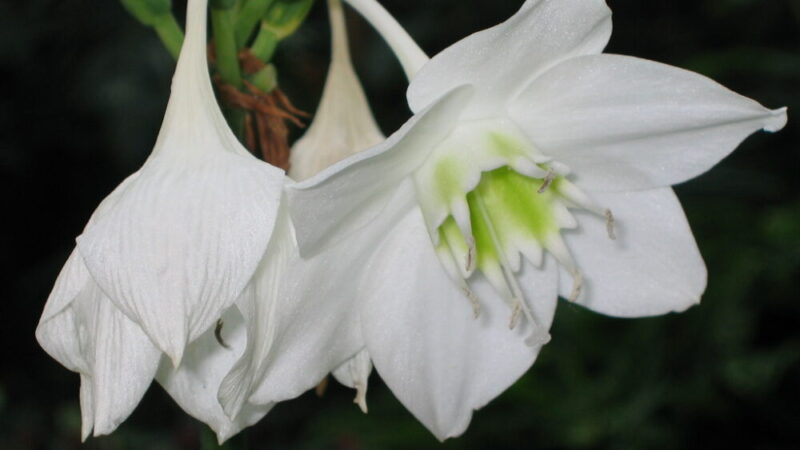Overwintering the Amazon lily

Successfully guiding your Amazon lily through the winter months is a crucial aspect of its annual care cycle, ensuring it not only survives but is also prepared for a vigorous burst of growth in the spring. Although typically grown as a houseplant in most climates and thus protected from true winter frosts, its needs change in response to the shorter days and lower light levels of the season. Winter is the plant’s natural period of rest and dormancy, a time when its metabolic processes slow down significantly. Recognizing this shift and adjusting your care routine accordingly is essential to prevent common winter problems like overwatering and root rot, and to allow the bulb to conserve the energy it will need for future flowering.
The primary change in winter care revolves around a significant reduction in watering. With less light available for photosynthesis and slower growth, the plant’s demand for water decreases dramatically. Continuing to water with the same frequency as you did in the summer is a direct path to creating waterlogged soil, which is especially dangerous in the cooler winter temperatures. It is imperative to allow the soil to dry out more thoroughly between waterings during this period. This careful water management is the single most important factor in ensuring the plant’s health throughout the winter.
Alongside reduced watering, all fertilization must be completely halted during the winter rest period. Since the plant is not actively growing, it cannot utilize the nutrients provided by fertilizer. Adding fertilizer to dormant soil is not only wasteful but also harmful, as the unused mineral salts can accumulate to toxic levels in the soil. This can cause chemical burns to the sensitive root system, damaging the plant at a time when it is already in a more vulnerable state. Feeding should only resume in the spring when you see clear signs of new growth.
While the Amazon lily needs a rest, it does not mean it should be placed in a cold, dark corner and forgotten. It still requires access to bright, indirect light, though the duration and intensity will naturally be less than in the summer. It is also important to protect the plant from cold drafts, which can be particularly prevalent near windows and doors during the winter. Maintaining a stable, cool-to-average room temperature and shielding it from sudden temperature drops will help it navigate its dormancy without unnecessary stress.
Understanding winter dormancy
Winter dormancy in an Amazon lily is a natural response to the changing environmental cues of the season, primarily the reduction in daylight hours and light intensity. This is not a state of decline but rather a strategic period of rest. During dormancy, the plant’s physiological processes, including photosynthesis and water uptake, slow down considerably. The primary goal of the plant during this time is to conserve energy within its bulb, storing it up for the vigorous growth and flowering that will come with the return of spring. Recognizing and respecting this phase is fundamental to successful long-term care.
More articles on this topic
The visible signs of dormancy are subtle but clear to an observant grower. You will notice that the plant stops producing new leaves, or that any new growth is extremely slow. The plant essentially enters a state of suspended animation, maintaining its existing foliage but not actively expanding. This is a clear signal from the plant that it is time for you to shift your care routine into “winter mode.” It is important not to misinterpret this lack of new growth as a sign of poor health and try to “fix” it with more water or fertilizer, as this will do more harm than good.
The length and depth of the dormancy period can vary depending on the specific conditions in your home. In a location that receives very little winter light, the dormancy will be more pronounced. In a brighter spot, the plant may slow down but not become fully dormant. Regardless, it is always best to err on the side of caution and reduce watering and cease fertilization for the core winter months. This rest period is not just for survival; it is a vital prerequisite for future blooming. Many bulbous plants, including the Amazon lily, require this period of rest to initiate the development of flower buds.
By providing the right conditions for dormancy, you are working in harmony with the plant’s natural rhythms. This period allows the bulb to mature and consolidate its energy reserves. Forcing the plant to grow continuously throughout the year without a rest can lead to exhaustion, resulting in weaker growth, smaller leaves, and a reluctance to flower. Embracing the winter rest period is an investment in the spectacular floral displays that you hope to enjoy in the seasons to come.
Adjusting your watering schedule
The most critical adjustment you must make for your Amazon lily during the winter is to its watering schedule. As the plant’s growth slows to a near standstill, its transpiration and water usage plummet. The soil will take much longer to dry out compared to the warmer, brighter months. Therefore, you must significantly increase the interval between waterings. Where you might have watered weekly in the summer, you may find that the plant only needs water every three, four, or even five weeks in the depths of winter.
More articles on this topic
The only reliable way to know when to water is to abandon any notion of a fixed schedule and rely entirely on a physical check of the soil. Before watering, insert your finger deep into the pot, at least 5-7 centimetres down. The soil should feel almost completely dry at this depth before you consider adding more water. In winter, it is always safer to underwater slightly than to overwater. The bulb stores a significant amount of water and can tolerate a period of dryness far better than it can tolerate sitting in cold, damp soil.
When you do water, continue to use the same thorough technique as in the summer. Water the soil evenly until it runs out of the drainage holes, then allow the pot to drain completely. This ensures the roots receive moisture but are not left in a stagnant pool. It is especially important in winter to empty the saucer immediately after watering. Allowing the pot to sit in cold water is one of the fastest ways to induce root rot, which is much more difficult for the plant to recover from during its dormant state.
Be mindful of the water temperature as well. Using very cold tap water can shock the plant’s dormant root system. It is always best to use room-temperature water. If you use tap water, allowing it to sit out not only helps dissipate chlorine but also ensures it warms up to the ambient temperature of the room. This small detail can reduce stress on the plant during its vulnerable winter rest, contributing to its overall health and readiness for spring.
Light and temperature considerations in winter
Even during its winter dormancy, the Amazon lily still requires adequate light to maintain the health of its existing leaves. While its need for light is reduced, it should not be moved to a dark location. The goal is to provide it with the brightest possible source of indirect light that your home has to offer during the shorter winter days. An east-facing window can be ideal, as can a spot near a south-facing window, as the winter sun is generally less intense and less likely to cause scorch. You may need to move the plant to a brighter location than its summer spot to compensate for the lower light levels.
Monitoring the plant’s leaves will tell you if it is getting enough light. If the leaves remain a deep, healthy green, the lighting is adequate. If they begin to look pale or start to yellow and die back excessively, it may be a sign that the location is too dark. It is normal for the plant to lose an occasional older leaf during the winter, but a rapid decline in foliage suggests a problem. Conversely, be aware that a window that was perfect in summer might receive more direct sun in the winter as the sun’s angle changes, so be prepared to adjust the plant’s position as needed.
Temperature management is also key during the winter months. The Amazon lily should be kept in a location with stable temperatures, ideally between 16°C and 21°C. While it appreciates the slightly cooler end of this range to encourage dormancy, it must be protected from significant temperature drops and cold drafts. Keep it away from poorly insulated windows where cold air can seep in, and avoid placing it near exterior doors or heating vents that can blast it with hot, dry air. A consistent and cool-to-mild temperature environment is ideal for its winter rest.
Think of the winter period as a time for maintenance and observation rather than active growth. It is a quiet phase in the plant’s life, but a crucial one. By providing the best possible light and temperature conditions, you are helping the plant get through this period with minimal stress. This ensures that when the days begin to lengthen in spring, the plant will have a healthy set of leaves ready to kickstart photosynthesis and the energy reserves in its bulb needed to produce a spectacular display of flowers.
📷: Flickr / Szerző: 阿橋花譜 HQ Flower Guide / Licence: CC BY-SA 2.0

















